Houze Robert A., Jr. Cloud Dynamics
Подождите немного. Документ загружается.

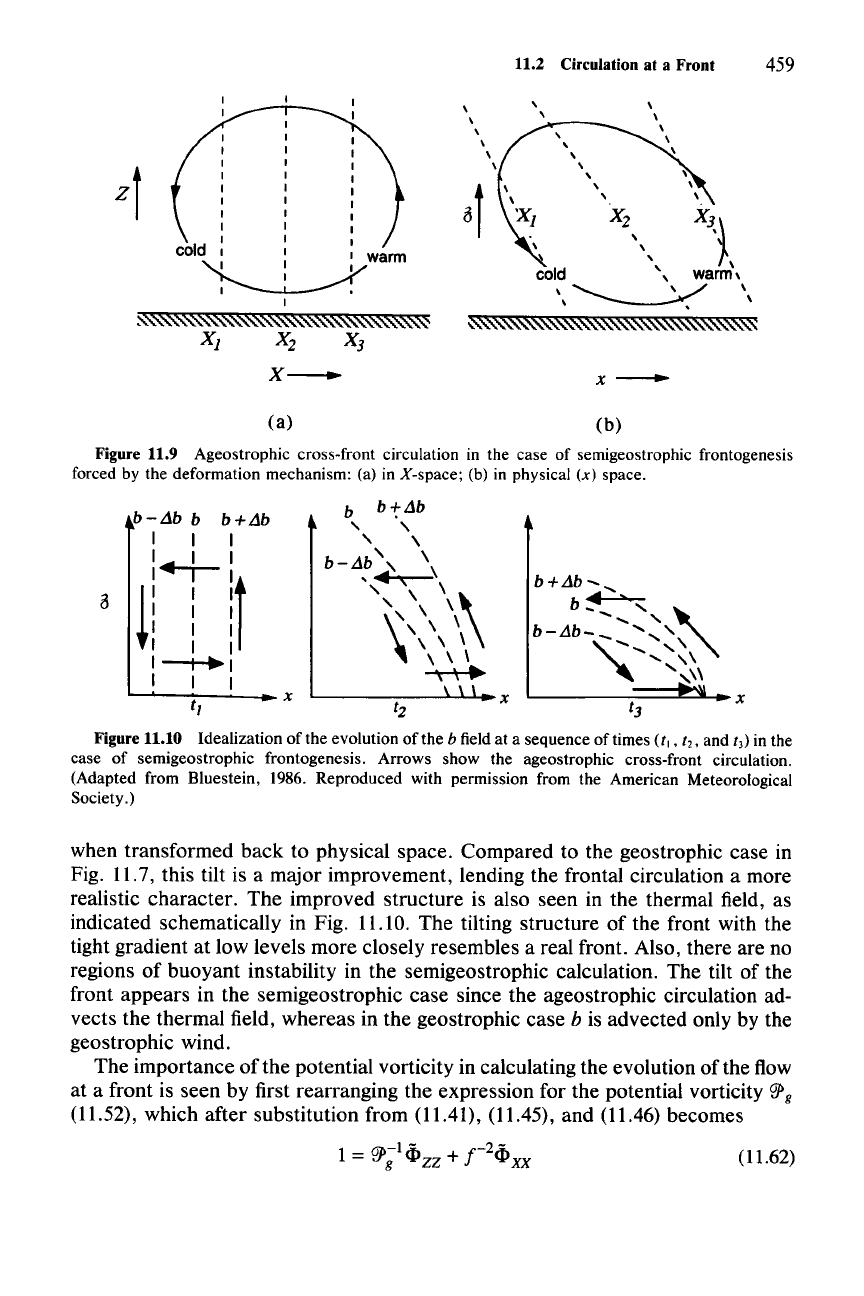
11.2 Circulation at a Front 459
x--
,
,
cold warm
~
~"'''"'"'~"'~"'"'~",,~"'"'"'"'"'"'"'~"'"'"'"'"'"'"'"'~
x, X
2
X3
X--
(a)
(b)
Figure 11.9 Ageostrophic cross-front circulation in the case of semigeostrophic frontogenesis
forced by the deformation mechanism: (a) in
X-space; (b) in physical
(x)
space.
b-Lib
b
b+Lib
I I I
I..J-I
!
:
-:
:f
I I I
I I I
I I I
I I
~I
I I I
t1
b b + Lib
, ,
, ,
b-Lib
-,
\
'~\
,,'
\ \
\'<\
\\
,\ \ \
~
b+Lib
.....
,
b~,~
b-Lib-
" "
~
...........
, ,
"
'"
',\\
L----==~i....x
Figure 11.10 Idealization of the evolution of the b field at a sequence oftimes
(tl
, t2, and t) in the
case of semigeostrophic frontogenesis. Arrows show the ageostrophic cross-front circulation.
(Adapted from Bluestein,
1986. Reproduced with permission from the American Meteorological
Society.)
when transformed back to physical space. Compared to the geostrophic case in
Fig. 11.7, this tilt is a major improvement, lending the frontal circulation a more
realistic character. The improved structure is also seen in the thermal field, as
indicated schematically in Fig. 11.10. The tilting structure of the front with the
tight gradient at low levels more closely resembles a real front. Also, there are no
regions of buoyant instability in the semigeostrophic calculation. The tilt of the
front appears in the semigeostrophic case since the ageostrophic circulation ad-
vects the thermal field, whereas in the geostrophic case
b is advected only by the
geostrophic wind.
The importance of the potential vorticity in calculating the evolution of the flow
at a front is seen by first rearranging the expression for the potential vorticity
r;}
g
(11.52), which after substitution from (11.41), (11.45), and (11.46) becomes
-1 -
-2
-
1 =
r;}g
<l»zz
+ f
<l»xx
(11.62)
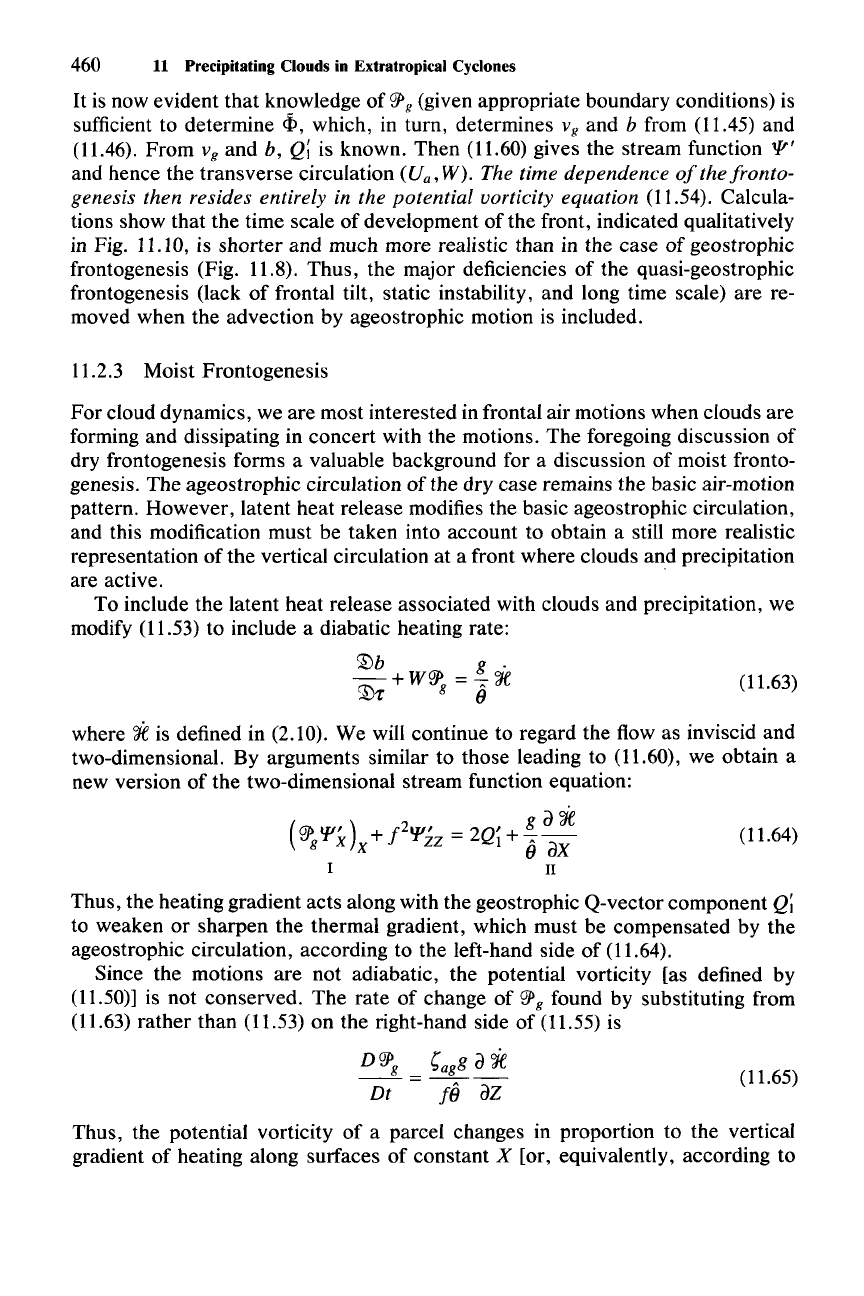
(11.63)
460
11 Precipitating Clouds in Extratropical Cyclones
It
is now evident that knowledge of
I!P
g (given appropriate boundary conditions) is
sufficient to determine
4>,
which, in turn, determines V
g
and b from (11.45) and
(11.46). From
v
g
and b,
Q;
is known. Then (11.60) gives the stream function
P'
and hence the transverse circulation
(U
a
,
W). The time dependence
of
the fronto-
genesis then resides entirely in the potential vorticity equation
(11.54). Calcula-
tions show that the time scale of development of the front, indicated qualitatively
in Fig. 11.10, is shorter and much more realistic than in the case
of
geostrophic
frontogenesis (Fig. 11.8). Thus, the major deficiencies of the quasi-geostrophic
frontogenesis (lack
of
frontal tilt, static instability, and long time scale) are re-
moved when the advection by ageostrophic motion is included.
11.2.3 Moist Frontogenesis
For
cloud dynamics, we are most interested in frontal air motions when clouds are
forming and dissipating in concert with the motions. The foregoing discussion of
dry frontogenesis forms a valuable background for a discussion of moist fronto-
genesis. The ageostrophic circulation
of
the dry case remains the basic air-motion
pattern. However, latent heat release modifies the basic ageostrophic circulation,
and this modification must be taken into account to obtain a still more realistic
representation of the vertical circulation at a front where clouds and precipitation
are active.
To include the latent heat release associated with clouds and precipitation, we
modify (11.53) to include a diabatic heating rate:
:1Jb
g .
~+W~
=--;::'lIe
~"
0
where 'if is defined in (2.10). We will continue to regard the flow as inviscid and
two-dimensional. By arguments similar to those leading to (11.60), we obtain a
new version of the two-dimensional stream function equation:
(
rill
Ill'
)
f2
lTP
,
g a
'lie
If.gT
X +
TZZ
= 2Q
1
+ --;::--
X 0
ax
I
IT
(11.64)
Thus, the heating gradient acts along with the geostrophic Q-vector component
Q;
to weaken or sharpen the thermal gradient, which must be compensated by the
ageostrophic circulation, according to the left-hand side of (11.64).
Since the motions are not adiabatic, the potential vorticity [as defined by
(11.50)] is not conserved. The rate of change of
I!P
g found by substituting from
(11.63) rather than (11.53) on the right-hand side of (11.55) is
Dl!P
g
Dt
(11.65)
Thus, the potential vorticity
of
a parcel changes in proportion to the vertical
gradient of heating along surfaces of constant X [or, equivalently, according to
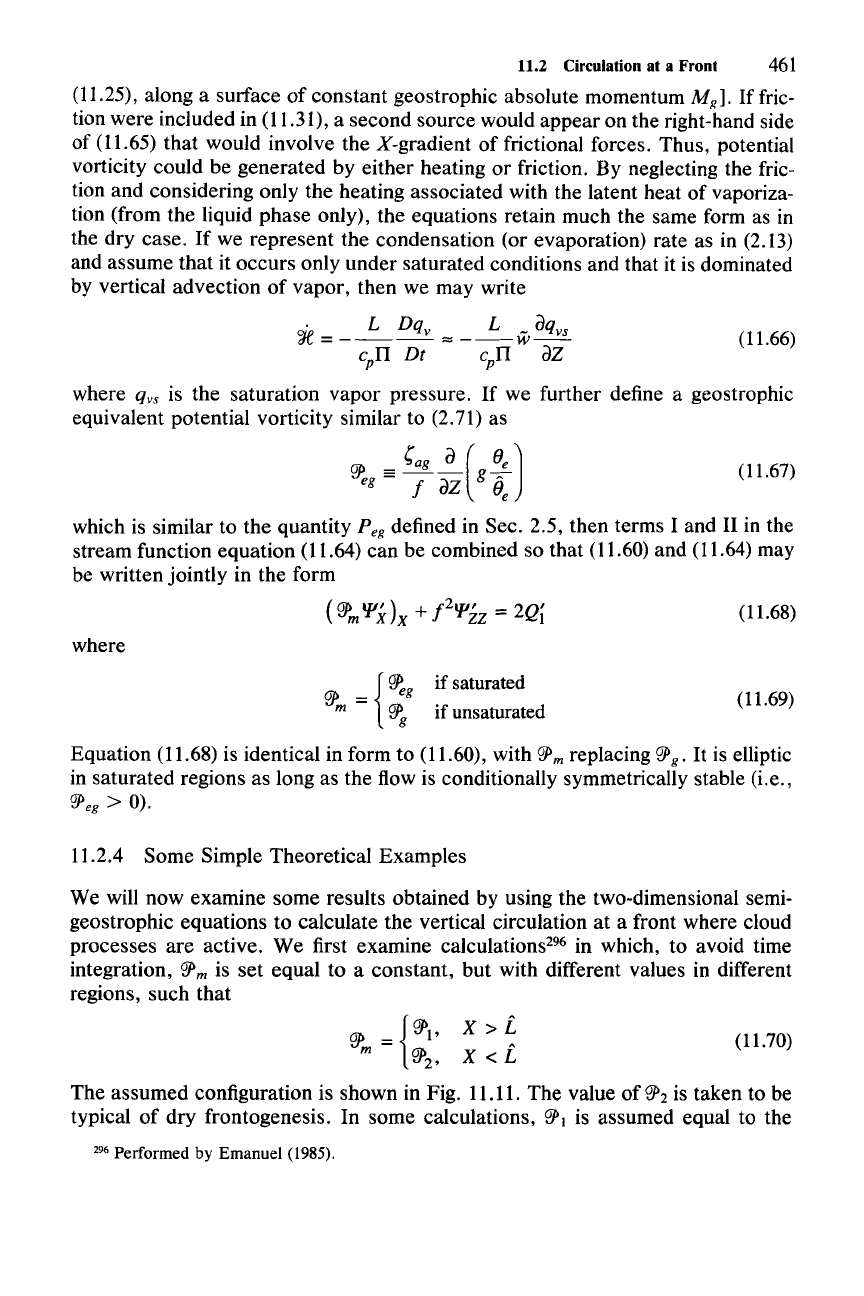
(11.67)
(11.69)
11.2 Circulation at a Front
461
(11.25), along a surface of constant geostrophic absolute momentum
Mil]'
If fric-
tion were included in (11.31), a second source would appear on the right-hand side
of (11.65) that would involve the X-gradient of frictional forces. Thus, potential
vorticity could be generated by either heating or friction. By neglecting the fric-
tion and considering only the heating associated with the latent heat of vaporiza-
tion (from the liquid phase only), the equations retain much the same form as in
the dry case.
If
we represent the condensation (or evaporation) rate as in (2.13)
and assume that it occurs only under saturated conditions and that it is dominated
by vertical advection of vapor, then we may write
. L Dq; L _
aqvs
'1Je
=
---
""
--w-
(11.66)
cpIl Dt cpIl
az
where
qvs
is the saturation vapor pressure. If we further define a geostrophic
equivalent potential vorticity similar to (2.71) as
c;
a (
(}e)
~g
==
f
az
g
Be
which is similar to the quantity
Pell
defined in Sec. 2.5, then terms I and
II
in the
stream function equation (11.64) can be combined so that (11.60) and (11.64) may
be written jointly in the form
(~m
'l'x)x + f
2
'l'zz =
2Qi
(11.68)
where
rJ}
= {
~g
if
saturated
m
~g
if unsaturated
Equation (11.68) is identical in form to (11.60), with
~
m replacing
~
II'
It
is elliptic
in saturated regions as long as the flow is conditionally symmetrically stable (i.e.,
~eg
> 0).
11.2.4 Some Simple Theoretical Examples
We will now examine some results obtained by using the two-dimensional semi-
geostrophic equations to calculate the vertical circulation at a front where cloud
processes are active. We first examine calculations-?" in which, to avoid time
integration,
~
m is set equal to a constant, but with different values in different
regions, such that
(jJ'> =
{~1'
x » L
lf
m
~2'
X < L (11.70)
The assumed configuration is shown in Fig. 11.11. The value of
~2
is taken to be
typical of dry frontogenesis. In some calculations,
W'l
is assumed equal to the
296 Performed by
Emanuel
(1985).
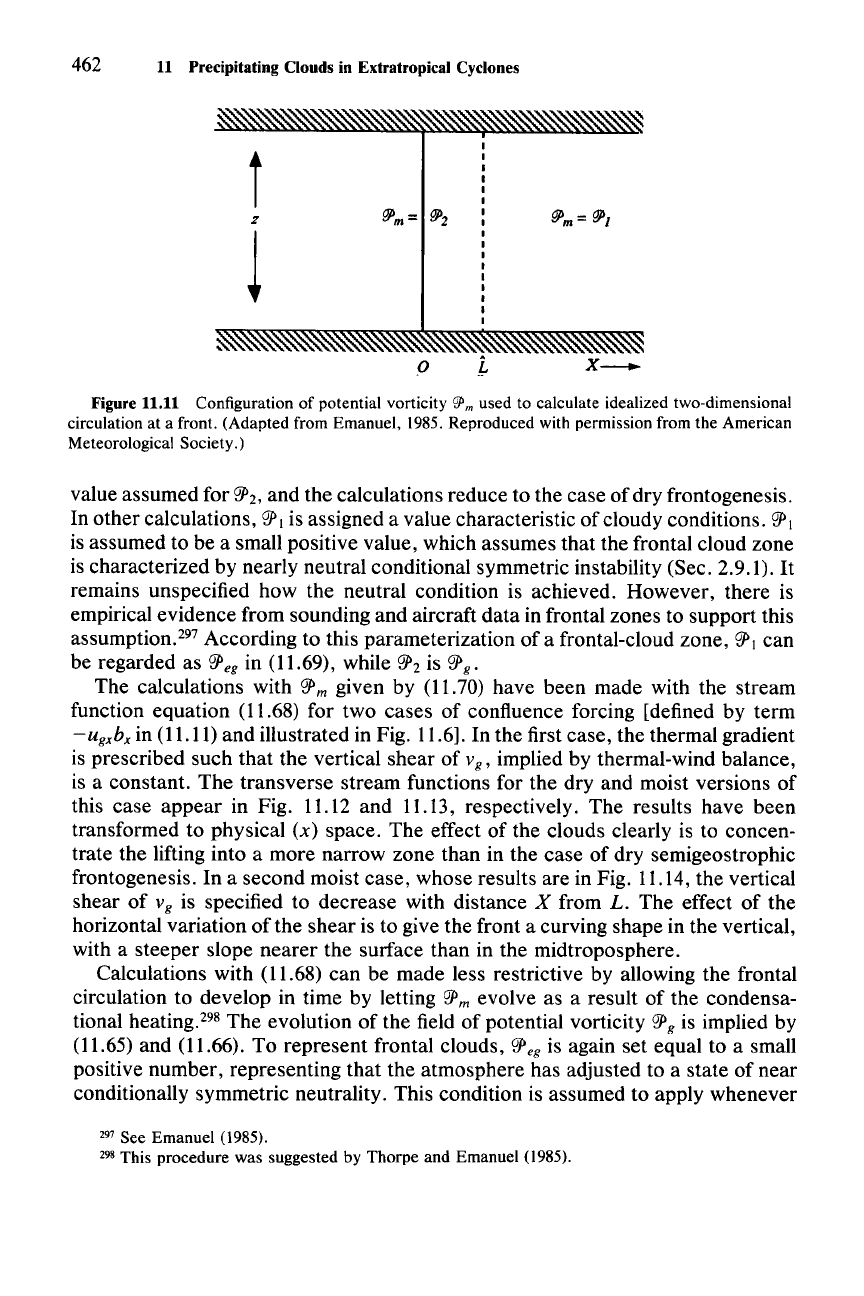
462 11 Precipitating Clouds in Extratropical Cyclones
t
z
eP
m
=
eP
z
eP
m
=
eP
J
1
~
0
i:
X-
Figure 11.11 Configuration of potential vorticity
'!J'm
used to calculate idealized two-dimensional
circulation at a front. (Adapted from Emanuel, 1985. Reproduced with permission from the American
Meteorological Society.)
value assumed for
rg>2,
and the calculations reduce to the case of dry frontogenesis.
In other calculations,
rg>,
is assigned a value characteristic of cloudy conditions.
rg>,
is assumed to be a small positive value, which assumes that the frontal cloud zone
is characterized by nearly neutral conditional symmetric instability (Sec. 2.9.1).
It
remains unspecified how the neutral condition is achieved. However, there is
empirical evidence from sounding and aircraft data in frontal zones to support this
assumption.P? According to this parameterization of a frontal-cloud zone,
rg>1
can
be regarded as
rg>
eg in (11.69), while
rg>2
is
rg>
g »
The calculations with
rg>
m given by (11.70) have been made with the stream
function equation (11.68) for two cases of confluence forcing [defined by term
-ugxb
x
in (11.11) and illustrated in Fig. 11.6]. In the first case, the thermal gradient
is prescribed such that the vertical shear of
v
g
,
implied by thermal-wind balance,
is a constant. The transverse stream functions for the dry and moist versions
of
this case appear in Fig. 11.12 and 11.13, respectively. The results have been
transformed to physical
(x)
space. The effect of the clouds clearly is to concen-
trate the lifting into a more narrow zone than in the case of dry semigeostrophic
frontogenesis. In a second moist case, whose results are in Fig. 11.14, the vertical
shear of
v
g
is specified to decrease with distance X from
L.
The effect of the
horizontal variation
of
the shear is to give the front a curving shape in the vertical,
with a steeper slope nearer the surface than in the midtroposphere.
Calculations with (11.68)
can
be made less restrictive by allowing the frontal
circulation to develop in time by letting
rg>
m evolve as a result of the condensa-
tional
heating?"
The evolution of the field of potential vorticity
rg>
g is implied by
(11.65) and (11.66). To represent frontal clouds,
rg>
eg is again set equal to a small
positive number, representing that the atmosphere has adjusted to a state of near
conditionally symmetric neutrality. This condition is assumed to apply whenever
297 See Emanuel (1985).
298 This procedure was suggested by Thorpe and Emanuel (1985).
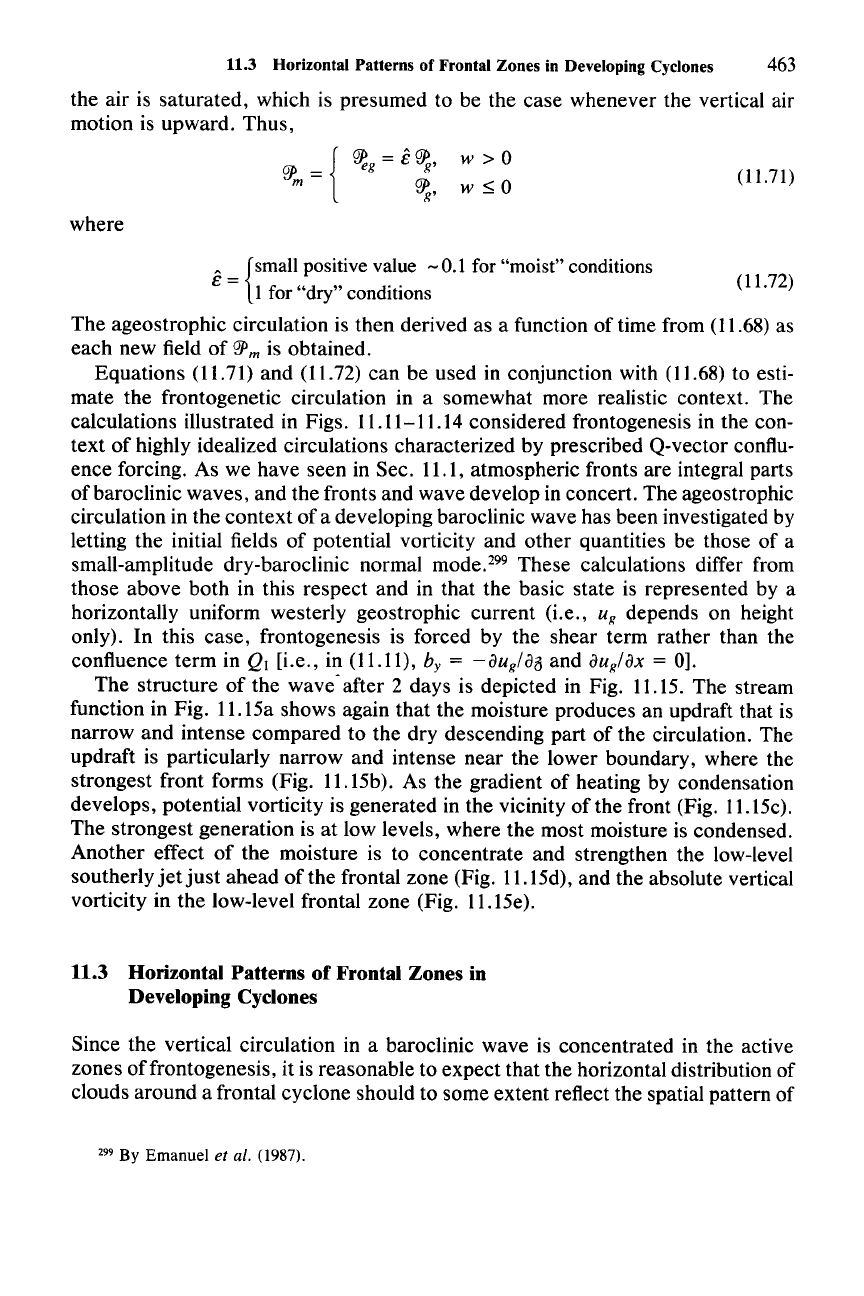
11.3 Horizontal Patterns of Frontal Zones in Developing Cyclones 463
the air is
saturated,
which is
presumed
to be the case whenever the vertical air
motion is upward.
Thus,
where
w > 0
w s 0
(11.71)
A _ {Smallpositive value - 0.1 for "moist" conditions
e (11.72)
- 1 for "dry" conditions
The
ageostrophic circulation is
then
derived as a function
of
time from (11.68) as
each
new
field
of
'!Pm
is obtained.
Equations
(11.71) and (11.72)
can
be used in conjunction with (11.68) to esti-
mate
the frontogenetic circulation in a somewhat more realistic context. The
calculations illustrated in Figs. 11.11-11.14 considered frontogenesis in the con-
text
of
highly idealized circulations characterized by prescribed Q-vector conflu-
ence forcing. As we have seen in Sec. 11.1, atmospheric fronts are integral parts
ofbaroclinic
waves, and the fronts and wave develop in concert. The ageostrophic
circulation in the
context
of
a developing baroclinic wave has been investigated by
letting the initial fields
of
potential vorticity and
other
quantities be those
of
a
small-amplitude dry-baroclinic normal mode.P? These calculations differ from
those
above
both
in this
respect
and in
that
the basic state is represented by a
horizontally uniform westerly geostrophic current (i.e.,
u
li
depends on height
only). In this
case,
frontogenesis is forced by the shear term rather than the
confluence
term
in QI [i.e., in (11.11), by = -auli/aa and
auli/ax
= 0].
The
structure
of
the wave- after 2 days is depicted in Fig. 11.15. The stream
function in Fig. 11.15a shows again
that
the moisture produces an updraft that is
narrow
and
intense
compared
to the dry descending part
of
the circulation. The
updraft is particularly
narrow
and intense near the lower boundary, where the
strongest front forms (Fig. 11.15b). As the gradient
of
heating by condensation
develops, potential vorticity is generated in the vicinity
of
the front (Fig. 11.15c).
The
strongest generation is at low levels, where the most moisture is condensed.
Another
effect
of
the moisture is to
concentrate
and strengthen the low-level
southerly
jet
just
ahead
of
the frontal zone (Fig. 11.15d), and the absolute vertical
vorticity in
the
low-level frontal zone (Fig. 11.15e).
11.3 Horizontal Patterns of Frontal Zones in
Developing
Cyclones
Since the vertical circulation in a baroclinic wave is concentrated in the active
zones
of
frontogenesis, it is reasonable to
expect
that
the horizontal distribution of
clouds around a frontal cyclone should to some
extent
reflect the spatial pattern of
299 By Emanuel et al. (1987).
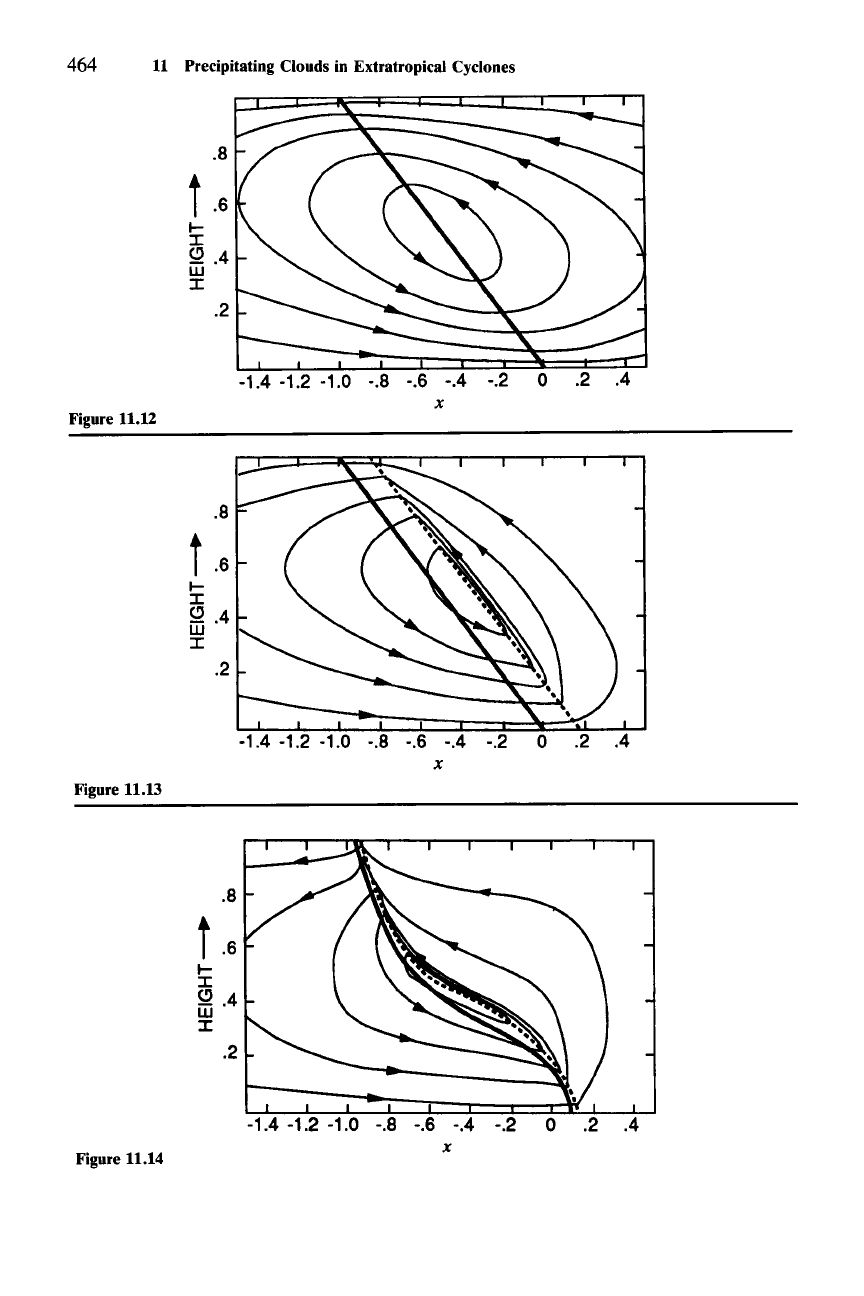
464 11 Precipitating Clouds in Extratropical Cyclones
.8
i .6
l-
I
~.4
w
I
.2
-1.4 -1.2 -1.0 -.8 -.6 -.4 -.2 0 .2 .4
x
Figure 11.12
.8
i .6
l-
I
~
.4
w
I
.2
-1.4 -1.2 -1.0 -.8 -.6 -.4 -.2 0 .2 .4
x
Figure 11.13
.8
i .6
l-
I
~
.4
w
I
.2
Figure 11.14
-1.4 -1.2 -1.0 -.8 -.6 -.4 -.2 0 .2 .4
x
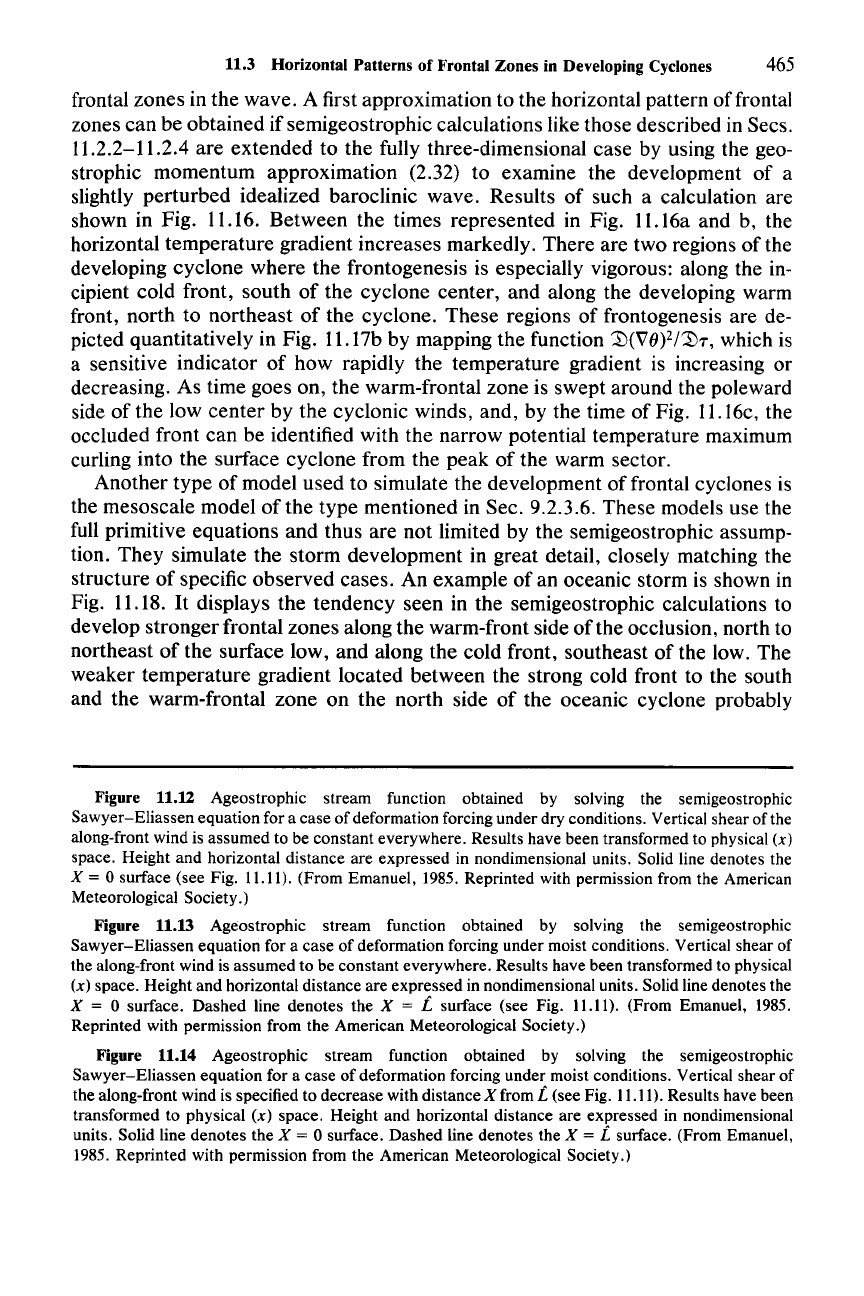
11.3 Horizontal Patterns of Frontal Zones in Developing Cyclones 465
frontal zones in the wave. A first approximation to the horizontal pattern offrontal
zones can be obtained if semigeostrophic calculations like those described in Sees.
11.2.2-11.2.4 are extended to the fully three-dimensional case by using the geo-
strophic momentum approximation (2.32) to examine the development of a
slightly perturbed idealized baroclinic wave. Results of such a calculation are
shown in Fig. 11.16. Between the times represented in Fig. 11.16a and b, the
horizontal temperature gradient increases markedly. There are two regions of the
developing cyclone where the frontogenesis is especially vigorous: along the in-
cipient cold front, south of the cyclone center, and along the developing warm
front, north to northeast of the cyclone. These regions of frontogenesis are de-
picted quantitatively in Fig. 11.17b by mapping the function
'JJ(V()2/'JJT, which is
a sensitive indicator of how rapidly the temperature gradient is increasing or
decreasing. As time goes on, the warm-frontal zone is swept around the poleward
side of the low center by the cyclonic winds, and, by the time of Fig. 11.16c, the
occluded front can be identified with the narrow potential temperature maximum
curling into the surface cyclone from the peak of the warm sector.
Another type of model used to simulate the development of frontal cyclones is
the mesoscale model of the type mentioned in Sec. 9.2.3.6. These models use the
full primitive equations and thus are not limited by the semigeostrophic assump-
tion. They simulate the storm development in great detail, closely matching the
structure of specific observed cases. An example of an oceanic storm is shown in
Fig. 11.18.
It
displays the tendency seen in the semigeostrophic calculations to
develop stronger frontal zones along the warm-front side of the occlusion, north to
northeast of the surface low, and along the cold front, southeast of the low. The
weaker temperature gradient located between the strong cold front to the south
and the warm-frontal zone on the north side of the oceanic cyclone probably
Figure 11.12 Ageostrophic stream function obtained by solving the semigeostrophic
Sawyer-Eliassen equation for a case of deformation forcing under dry conditions. Vertical shear of the
along-front wind is assumed to be constant everywhere. Results have been transformed to physical
(x)
space. Height and horizontal distance are expressed in nondimensional units. Solid line denotes the
X = 0 surface (see Fig. 11.11). (From Emanuel, 1985. Reprinted with permission from the American
Meteorological Society.)
Figure 11.13 Ageostrophic stream function obtained by solving the semigeostrophic
Sawyer-Eliassen equation for a case of deformation forcing under moist conditions. Vertical shear of
the along-front wind is assumed to be constant everywhere. Results have been transformed to physical
(x) space. Height and horizontal distance are expressed in nondimensional units. Solid line denotes the
X = 0 surface. Dashed line denotes the X = t. surface (see Fig. 11.11). (From Emanuel, 1985.
Reprinted with permission from the American Meteorological Society.)
Figure 11.14 Ageostrophic stream function obtained by solving the semigeostrophic
Sawyer-Eliassen equation for a case of deformation forcing under moist conditions. Vertical shear of
the along-front wind is specified to decrease with distance
X from t. (see Fig. 11.11). Results have been
transformed to physical
(x)
space. Height and horizontal distance are expressed in nondimensional
units. Solid line denotes the
X = 0 surface. Dashed line denotes the X = t. surface. (From Emanuel,
1985. Reprinted with permission from the American Meteorological Society.)
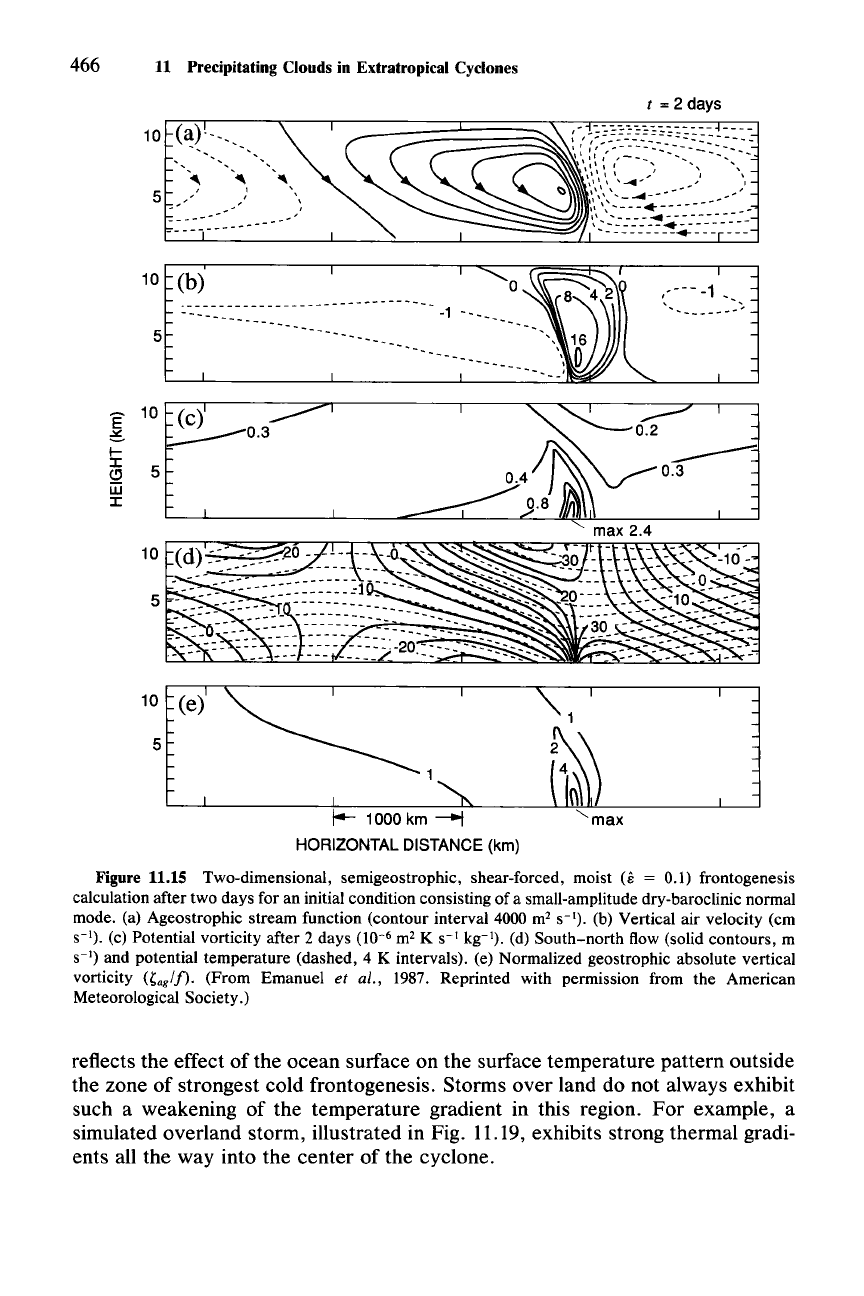
466 11 Precipitating Clouds in Extratropical Cyclones
t = 2 days
5
E 10 (c)
~
0.3
I-
a 5
W
::c
'"
,
r
---------=
0.3
Figure 11.15 Two-dimensional, sernigeostrophic, shear-forced, moist (e = 0.1) frontogenesis
calculation after two days for an initial condition consisting of a small-amplitude dry-baroclinic normal
mode. (a) Ageostrophic stream function (contour interval 4000 m
2
S-I). (b) Vertical air velocity (ern
S-I). (c) Potential vorticity after 2 days (10-
6
m
2
K S-I kg-I). (d) South-north flow (solid contours, m
S-I) and potential temperature (dashed, 4 K intervals). (e) Normalized geostrophic absolute vertical
vorticity
(~ag/f).
(From Emanuel et al., 1987. Reprinted with permission from the American
Meteorological Society.)
reflects the effect of the ocean surface on the surface temperature pattern outside
the zone of strongest cold frontogenesis. Storms over land do not always exhibit
such a weakening of the temperature gradient in this region.
For
example, a
simulated overland storm, illustrated in Fig. 11.19, exhibits strong thermal gradi-
ents all the way into the center of the cyclone.
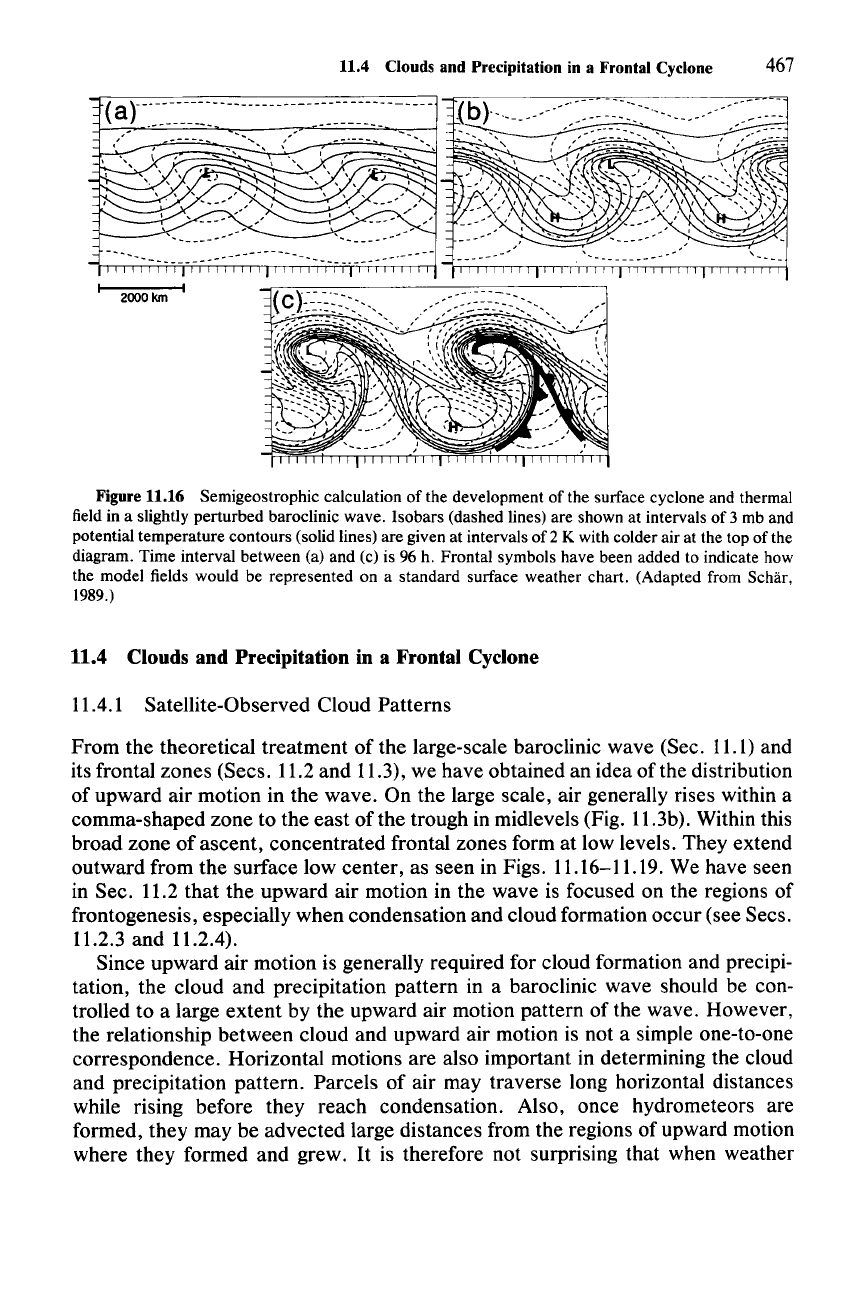
11.4 Clouds and Precipitation in a Frontal Cyclone 467
Figure 11.16 Semigeostrophic calculation of the development of the surface cyclone and thermal
field in a slightly perturbed baroclinic wave. Isobars (dashed lines) are shown at intervals of 3 mb and
potential temperature contours (solid lines) are given at intervals of 2 K with colder air at the top of the
diagram. Time interval between (a) and (c) is
96 h. Frontal symbols have been added to indicate how
the model fields would be represented on a standard surface weather chart. (Adapted from Schar,
1989.)
11.4 Clouds and Precipitation in a Frontal Cyclone
11.4.1 Satellite-Observed Cloud Patterns
From the theoretical treatment of the large-scale baroclinic wave (Sec. 11.1) and
its frontal zones (Sees. 11.2 and 11.3), we have obtained an idea of the distribution
of upward air motion in the wave. On the large scale, air generally rises within a
comma-shaped zone to the east
ofthe
trough in midlevels (Fig. 11.3b). Within this
broad zone of ascent, concentrated frontal zones form at low levels. They extend
outward from the surface low center, as seen in Figs. 11.16-11.19. We have seen
in Sec. 11.2 that the upward air motion in the wave is focused on the regions of
frontogenesis, especially when condensation and cloud formation occur (see Sees.
11.2.3 and 11.2.4).
Since upward air motion is generally required for cloud formation and precipi-
tation, the cloud and precipitation pattern in a baroclinic wave should be con-
trolled to a large extent by the upward air motion pattern of the wave. However,
the relationship between cloud and upward air motion is not a simple one-to-one
correspondence. Horizontal motions are also important in determining the cloud
and precipitation pattern. Parcels of air may traverse long horizontal distances
while rising before they reach condensation. Also, once hydrometeors are
formed, they may be advected large distances from the regions of upward motion
where they formed and grew.
It
is therefore not surprising that when weather
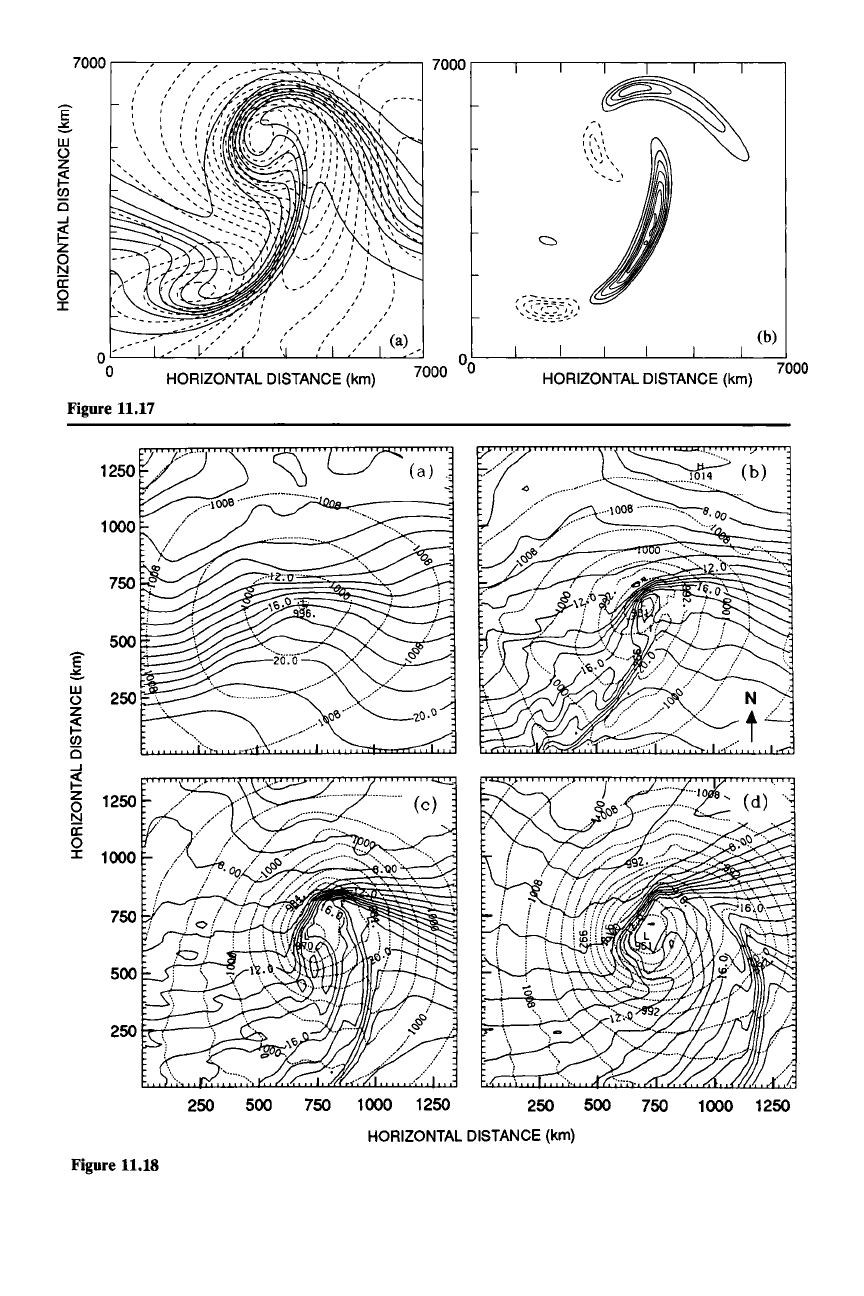
7000
,---.-------.----.----.------.-----...,--,
HORIZONTAL
DISTANCE
(km)
7000
(b)
,-,~~
u'
I 1\'
\\,1\
" ,
, '
--'
7000
0
0
(a)
HORIZONTAL
DISTANCE
(km)
7000
,
r
,
E
,
,
6
UJ
0
Z
~
(J)
is
...J
~
Z
0
N
a:
0
::c
a
a
Figure 11.17
;[
UJ
o
z
~
(J)
is
...J
~
z
2
a:
o
::c
250
500 750
1000 1250
250
500
750 1000
1250
HORIZONTAL
DISTANCE
(km)
Figure 11.18
